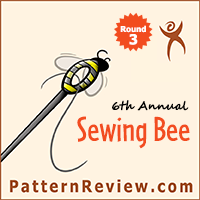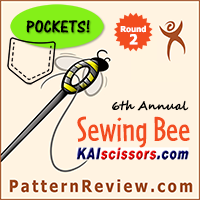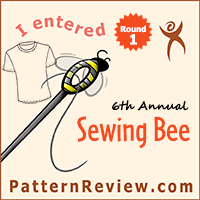

When a round of the sewing bee is announced, I carefully read the announcement, all the while mentally scanning my list of things to sew. I have maintained a list of things I would like to sew for several decades. It started while I worked and raised my family. Back then sewing time was precious and very limited. It allowed me to hit the ground running when I did find time to sew. My list is not just a written list of projects – it consists of patterns, pictures of garments, swatches of fabrics, and notes on techniques. These are the seeds of my inspiration. When the sewing bee round is announced, I pull my ideas from my list and formulate a plan that incorporates the theme of the contest while also tackling as many “to sew” actions from my list. Now that I am retired, I pick away at my list pretty steadily. When I am participating in the sewing bee I go into warp speed. I try to incorporate as many of my sewing to dos as I can. Luckily inspiration is bountiful and my list of things to sew continues to grow faster than I can keep up with even during sewing bee.
Recycled denim was a bit of a challenge. I am an avid quilter, but quilted or patchwork clothing never appealed to me. The patchwork garments I made over the years never made it out of my closet. I admire the artistry of fashioning new garments from the pieces of clothing. But, I would not wear a Frankenstein garment that was obviously comprised of sections from other garments. Recycling is about minimizing waste, using resources efficiently, and repurposing. Making something I knew would never be worn was a non-starter. I finally settled on the Tuxedo blouse and a corseted belt. These two articles have been languishing on my list for far too long. Although I love sewing for family and friends, when it comes to the sewing bee, I could never ask someone to put up with the many try on sessions, so the garments would be for me. I immediately dug out two pairs of store bought stretch jeans in dark navy denim that I purchased just before lock-down. One of the pairs still had the tags on it. I had hoped the stretch would help to accommodate my unique physique, but it was not to be. A friend donated a beautiful faded light denim shirt. I went to a local thrift shop and purchased two more pairs of dark navy stretch jeans, and a denim skirt in a medium blue. These six garments would be the source for my projects. The Tuxedo blouse would be made from the four pairs of dark stretch jeans. The belt would be lighter in color adding more shape and contrast to the outfit, using both sides of the denim skirt. The beloved denim shirt from a friend would be used for lining in both pieces.
While formulating this plan, I took careful inventory of the fabric I had available. I did not cut the denim from the pants or skirt, until I could pin all the necessary pattern pieces on the denim. Some of the pieces had to be cut single layer, requiring extra attention to make sure I cut an up and down version of a pattern piece. This added a lot of stress to this project as I had very little margin for error. In some cases, I would sew test pieces out of other fabric to fine tune the fit, before the final pattern pieces were cut from the denim. On the back inside of the cuffs, you will find a dark spot of denim, which originally fell under the back pocket. I was so tight for dark denim I had no other choice for the cuffs. I think it adds authenticity to my recycling efforts. Also in the lower hem facing I was forced to use a piece of denim that originally had a pocket on it, and you can still make out the pocket outline. I am proud of how little was left of my original garments. I included a photo of the source garments before and after. Among the cast offs, there are useful sized pieces left destined for other projects, so I will have to find them a home.
The Tuxedo blouse made it on to my list several years ago at a sewing class. A fellow student was wearing her creation and I kept staring at the design lines and searching for construction clues. I finally asked her about the pattern. It is the Tuxedo shirt from Sandra Betzina’s book, “No Time to Sew”. It is a winged collar blouse, with simple relaxed long sleeves with no cuffs, and the bottom hem line was like none I had seen before. It would flatter a variety of shapes and sizes. I bought the book, and the patterns. The reason this project lingered on my list was the pattern accommodated small, medium, and large. The largest hip measurement was 24” smaller than my hips. The bodice would also need grading, and the original pattern had no shaping in the way of darts or princess seams. Also, the pattern called for lighter fabric with more drape. But, I thought the denim would add structure to garment accenting its strong design lines and being more flattering to my figure.
Not one to give up, I formulated a plan. I would use a self-drafted princess seam bodice, that I can fit easily, and I had already drafted a pattern for a flip cuff sleeve for the bodice. These had the benefit of using many smaller pieces which could be cut from the legs of jeans. I used the winged collar pattern piece from the original pattern, adjusting it to fit on my bodice’s neckline. For the bottom I had no existing patterns that would approximate the shape. I started from a circle skirt, reducing the flare to just skim my hips. In the original pattern there is not a waistline seam. The need to keep pattern pieces small forced me to add a waistline seam and to increase the number of panels in the peplum. To approximate the original pattern I wanted the peplum to flow smoothly from the waist. The bottom hemline was drafted as close as possible from the original pattern. Not being a fan of buttonholes in denim, I changed the front button placket on the original pattern to a cut-on hidden button placket that ended at the waist. This resulted in a garment with sharp crisp, clean, classic design lines, similar to the original pattern.
Once I had drafted the pattern, the construction was fairly straight forward. All seams were finished with a serged edge. I minimized topstitching to where it was needed and did it in matching thread to keep the look clean and sharp. I made covered buttons to maintain the design uniformity. The button loops on the cuffs are made using soft elastic covered with a two pass rolled edge done on my serger using matching thread. Gail Yellen has an excellent video demonstrating this technique. It results in a perfect matching elastic. Grading was extremely important to complete the collar and button stands. I recommend Muna and Board’s sew along for the Noice Jeans as my all-time favorite demonstration of how to grade denim. I used the lighter denim from the gifted shirt, to make the hem facing. The shirt was pretty stained and paint splattered, so I used the wrong side to get a more uniform look. The peplum consists of 10 panels, which was necessary to be able to cut them from the jean legs. When cutting, I managed to maintain grain-line on the top portion of garment. The sleeves had to be pieced. The bottom pieces had to be cut off grain, but the bias I think actually enhances the drape of the peplum. I absolutely love slipping this blouse on. The denim is soft with a slight stretch. The garment offers coverage without being oversized. I truly look forward to making another of these with ample fabric to allow combining some of the many pieces, so it is back on my “to sew” list. The blouse had the correct proportions for my body, and it would be perfect to showcase my accessory, a belt.
A corset was on my “to sew” list as well. I knew my first corset should not and could not be rushed, but a corseted belt would be an excellent way to familiarize myself with some of the techniques needed to someday make my own corset. View D from Simplicity pattern 8626 caught my eye, but I liked the back of it. Starting with that pattern I drafted a pattern which featured a front centered zipper to allow easier on/off. I added a laced section in the back. I added 4” to the pattern to accommodate my waist. Adding sections while reducing their size allowed me to add a lot more boning, which is installed in the seam allowances. The laced panel was designed to allow me to cinch the belt in or out up to 1.5 inches, which makes it versatile when pairing with lighter or bulkier outfits. The lacing is a thick cotton cording, and my husband saved the day by suggesting heat shrink tubing to seal the ends of laces to prevent fraying. The belt buckle was repurposed from a belt purchased at the thrift store. I also backed my sections with Peltex 70, ultra-firm stabilizer. It is 100% polyester and machine wash and tumble dry. This resulted in a very comfortable supportive belt. The amount of work to install a zipper, a belt buckle, 16 pieces of boning, 13 grommets, 2 rivets, throughout the 9 sections of the belt, has given me a new found appreciation for accessories, and I will never complain about the price of a well-made belt again. I used the denim skirt for the belt. I used the wrong side of the denim for the two front belt pieces to add a bit more contrast. I used the rest of the denim shirt to line the belt sections. I love this belt, and look forward to wearing it with many of my outfits. I could never purchase a belt that is this comfortable to wear while giving me the shape and support I want. I plan on making another of these too, which is why my “to sew” list never stops growing.
As for my list, here is some of the “new to me” techniques that I used during this project: making covered buttons, making matching elastic loops, drafting a cut on hidden button placket, installing grommets, lacing a corset, installing a belt buckle, shortening a metal separating zipper, and adding boning to a garment to name a few.
Once again, the sewing bee has done its magic, and in record time I have boldly challenged myself to draft and make a garment and an accessory for myself. Thank you to all those behind the scenes that make it possible, and thanks to my fellow participants who not only understand the joy and excitement of sewing bee mania, but who also inspire me with their creativity and willingness to share!



















































